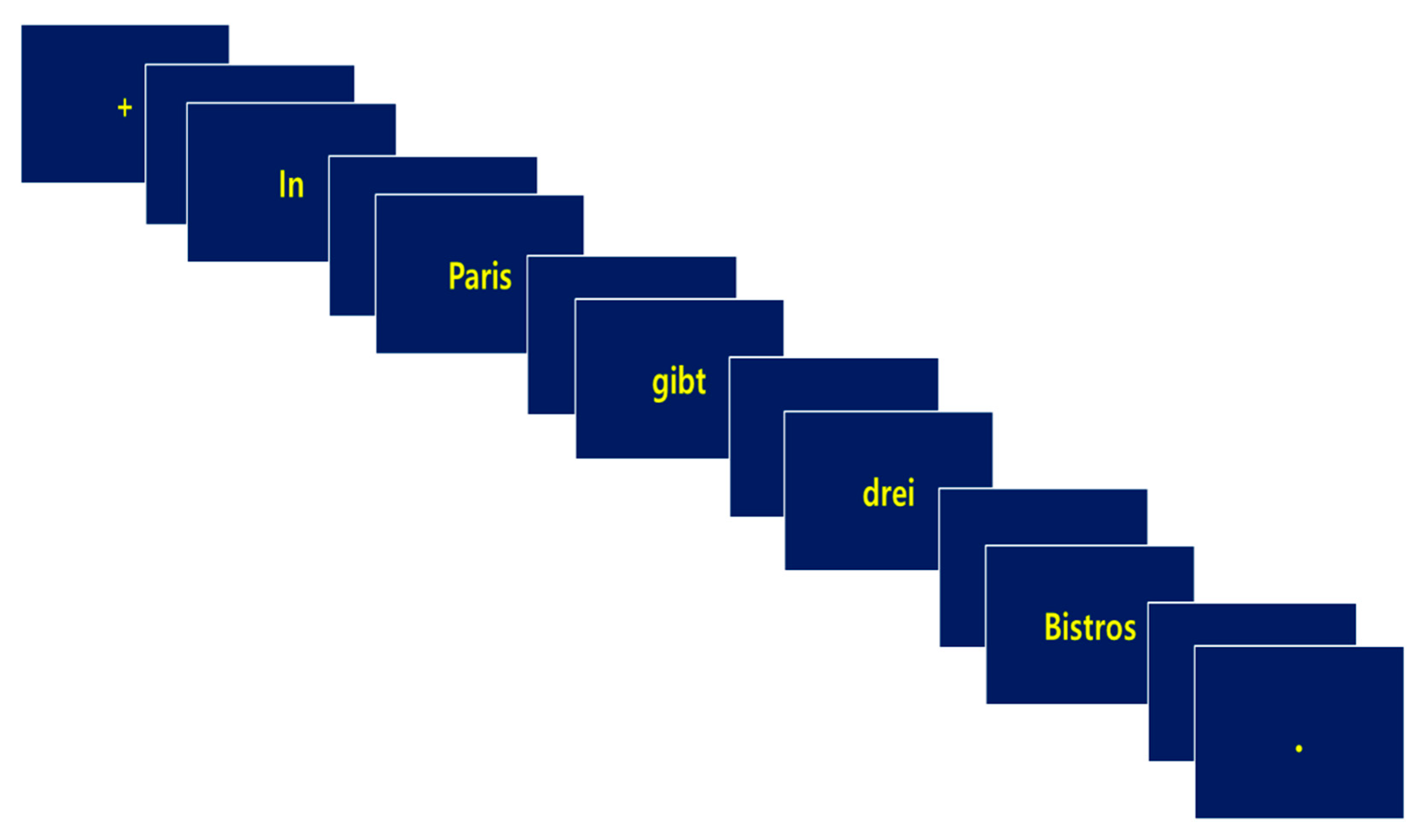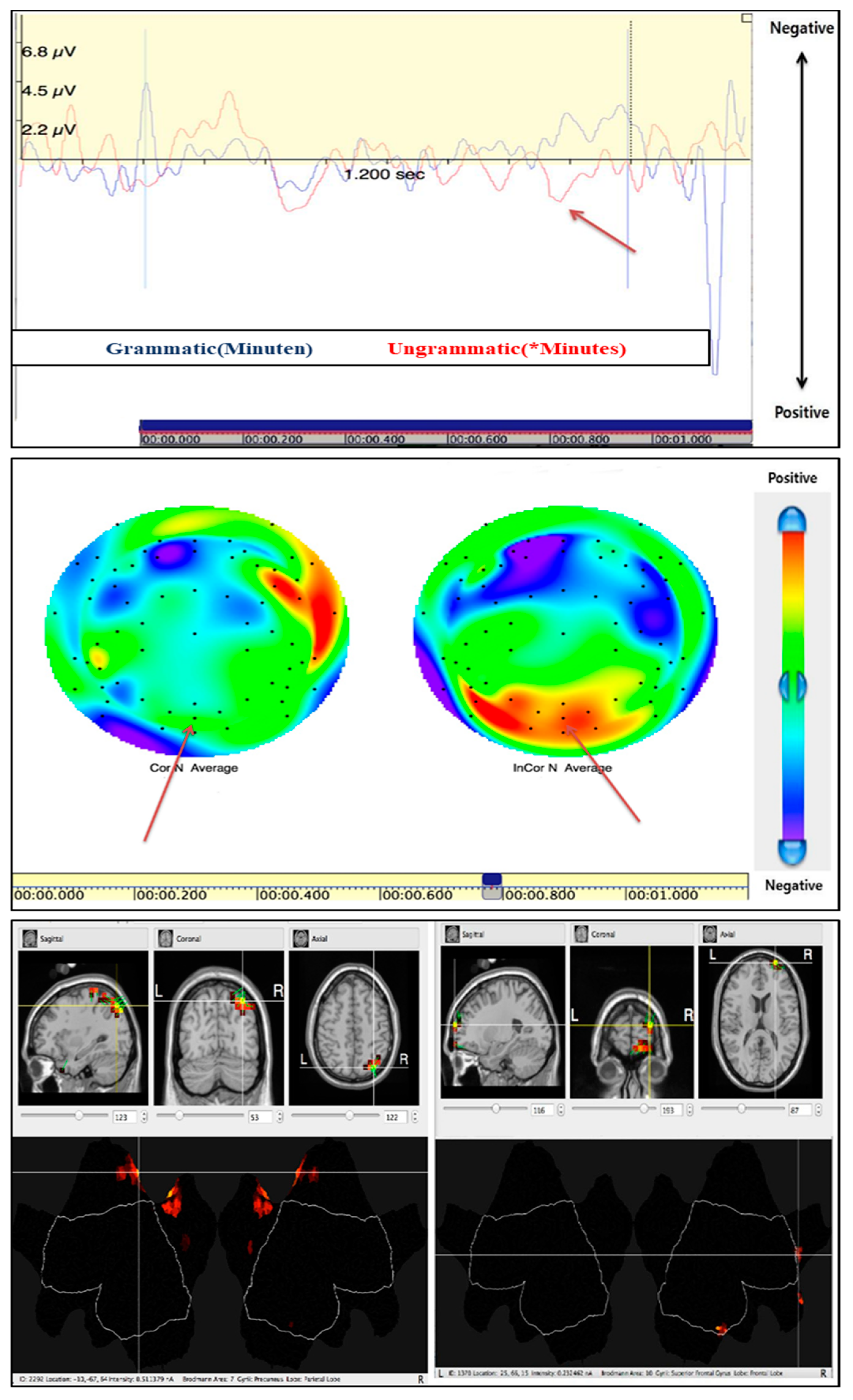Morpheme Analysis Associated with German Noun Plural Endings among Second Language (L2) Learners Using Event-Related Potentials (ERPs)
Abstract
1. Introduction
2. Experimental Procedures
2.1. Participants
2.2. Materials
2.3. Procedures
2.4. EEG Recording and Data Analysis
2.5. Data Analysis
3. Results
3.1. Behavioral Results
3.2. Event-Related Potentials Results
3.2.1. Irregular Ending Violation: N400
3.2.2. Regular Ending Violation: LAN
3.2.3. Regular Ending Violation: P600
3.3. Statistical Results
3.3.1. 300–450 ms
3.3.2. 450–600 ms
3.3.3. 600–800 ms
4. Discussion
5. Conclusions
Funding
Conflicts of Interest
References
- Hahne, A. What’s different in second-language processing? Evidence from event-related brain potentials. J. Psycholinguist. Res. 2001, 30, 251–266. [Google Scholar] [CrossRef]
- Hahne, A.; Friederici, A.D. Processing a second language: Late learners’ comprehension mechanisms as revealed by event-related brain potentials. Biling. Lang. Cogn. 2001, 4, 123–141. [Google Scholar] [CrossRef]
- Hong, U.P. Zur (Ir-) Regularitat der nominalen Flexionsregeln (Plural) im Deutschen. Ger. Lit. 1995, 56, 353–368. [Google Scholar]
- Hong, U.P.; Choi, M.W. Reprasentation und Verarbeitung von Pluralformen im Deutschen als Zweitsprache. Ger. Lang. Lit. 2004, 26, 1–20. [Google Scholar]
- Choi, M.W. Die Praferenzen und der Lerneffekt der Pluralbildungssuffixe im Deutschen von koreanischen Erstsprachlern nach den Lernphasen. Ger. Lang. Lit. 2014, 65, 121–142. [Google Scholar]
- Clahsen, H. Lexical entries and rules of language: A multidisciplinary study of German inflection. Behav. Brain Sci. 1999, 22, 991–1013. [Google Scholar] [CrossRef]
- Marcus, G.F.; Brinkmann, U.; Clahsen, H.; Wiese, R.; Pinker, S. German inflection: The exception that proves the rule. Cogn. Psychol. 1995, 29, 189–256. [Google Scholar] [CrossRef]
- Butterworth, B. Language Production; Academic Press: London, UK, 1983; Volume 2. [Google Scholar]
- Seidenberg, M.S.; Gonnerman, L.M. Explaining derivational morphology as the convergence of codes. Trends Cogn. Sci. 2000, 4, 353–361. [Google Scholar] [CrossRef]
- McClelland, J.L.; Rogers, T.T. The parallel distributed processing approach to semantic cognition. Nat. Rev. Neurosci. 2003, 4, 310–322. [Google Scholar] [CrossRef]
- Taft, M. Recognition of affixed words and the word frequency effect. Mem. Cogn. 1979, 7, 263–272. [Google Scholar] [CrossRef]
- Taft, M. Lexical access codes in visual and auditory word recognition. Lang. Cogn. Process. 1986, 1, 297–308. [Google Scholar] [CrossRef]
- Friederici, A.D.; Pfeifer, E.; Hahne, A. Event-related brain potentials during natural speech processing: Effects of semantic, morphological and syntactic violations. Cogn. Brain Res. 1993, 1, 183–192. [Google Scholar] [CrossRef]
- Ullman, M.T. The neural basis of lexicon and grammar in first and second language: The declarative/procedural model. Biling. Lang. Cogn. 2001, 4, 105–122. [Google Scholar] [CrossRef]
- Baayen, R.H.; Dijkstra, T.; Schreuder, R. Singulars and plurals in Dutch: Evidence for a parallel dual-route model. J. Mem. Lang. 1997, 37, 94–117. [Google Scholar] [CrossRef]
- Penke, M.; Krause, M. German noun plurals: A challenge to the dual-mechanism model. Brain Lang. 2002, 81, 303–311. [Google Scholar] [CrossRef][Green Version]
- Pinker, S.; Prince, A. Regular and irregular morphology and the psychological status of rules of grammar. Real. Linguist. Rules 1994, 321, 51. [Google Scholar]
- Sonnenstuhl, I.; Huth, A. Processing and representation of German-n plurals: A dual mechanism approach. Brain Lang. 2002, 81, 276–290. [Google Scholar] [CrossRef]
- Rodriguez-Fornells, A.; Clahsen, H.; Lleo, C.; Zaake, W.; Münte, T.F. Event-related brain responses to morphological violations in Catalan. Cogn. Brain Res. 2001, 11, 47–58. [Google Scholar] [CrossRef]
- Say, T.; Clahsen, H. Words, rules and stems in the Italian mental lexicon. In Storage and Computation in the Language Faculty; Springer: Berlin, Germany, 2002; pp. 93–129. [Google Scholar]
- Mueller, J.L.; Hahne, A.; Fujii, Y.; Friederici, A.D. Native and nonnative speakers’ processing of a miniature version of Japanese as revealed by ERPs. J. Cogn. Neurosci. 2005, 17, 1229–1244. [Google Scholar] [CrossRef]
- Van Hell, J.G.; Tokowicz, N. Event-related brain potentials and second language learning: Syntactic processing in late L2 learners at different L2 proficiency levels. Second Lang. Res. 2010, 26, 43–74. [Google Scholar] [CrossRef]
- Sabourin, L.; Stowe, L.A. Second language processing: When are first and second languages processed similarly? Second Lang. Res. 2008, 24, 397–430. [Google Scholar] [CrossRef]
- Kutas, M.; Hillyard, S.A. Reading senseless sentences: Brain potentials reflect semantic incongruity. Science 1980, 207, 203–205. [Google Scholar] [CrossRef] [PubMed]
- Hagoort, P.; Hald, L.; Bastiaansen, M.; Petersson, K.M. Integration of word meaning and world knowledge in language comprehension. Science 2004, 304, 438–441. [Google Scholar] [CrossRef] [PubMed]
- Osterhout, L.; Holcomb, P.J. Event-related brain potentials elicited by syntactic anomaly. J. Mem. Lang. 1992, 31, 785–806. [Google Scholar] [CrossRef]
- Kaan, E.; Harris, A.; Gibson, E.; Holcomb, P. The P600 as an index of syntactic integration difficulty. Lang. Cogn. Process. 2000, 15, 159–201. [Google Scholar] [CrossRef]
- MacWhinney, B.; James, J.S.; Schunn, C.; Li, P.; Schneider, W. STEP—A system for teaching experimental psychology using E-Prime. Behav. Res. Methods Instrum. Comput. 2001, 33, 287–296. [Google Scholar] [CrossRef]
- Weyerts, H.; Penke, M.; Dohrn, U.; Clahsen, H.; Münte, T.F. Brain potentials indicate differences between regular and irregular German plurals. NeuroReport 1997, 8, 957–962. [Google Scholar] [CrossRef]
- Hahne, A.; Mueller, J.L.; Clahsen, H. Morphological processing in a second language: Behavioral and event-related brain potential evidence for storage and decomposition. J. Cogn. Neurosci. 2006, 18, 121–134. [Google Scholar] [CrossRef]
- Weber, K.; Lavric, A. Syntactic anomaly elicits a lexico-semantic (N400) ERP effect in the second language but not the first. Psychophysiology 2008, 45, 920–925. [Google Scholar] [CrossRef]
- Pascual-Marqui, R.D. Standardized low-resolution brain electromagnetic tomography (sLORETA): Technical details. Methods Find. Exp. Clin. Pharmacol. 2002, 24, 5–12. [Google Scholar]
- Kutas, M.; Van Petten, C. Psycholinguistics electrified. In Handbook of Psycholinguistics; Academic Press: Cambridge, MA, USA, 1994; pp. 83–143. [Google Scholar]
- Krueger, C.; Tian, L. A comparison of the general linear mixed model and repeated measures ANOVA using a dataset with multiple missing data points. Biol. Res. Nurs. 2004, 6, 151–157. [Google Scholar] [CrossRef] [PubMed]
- Brosius, F. SPSS 21; MITP-Verlags GmbH & Co. KG: München, Germany, 2013. [Google Scholar]
- Bosch-Bayard, J.; Aubert-Vazquez, E.; Brown, S.T.; Rogers, C.; Kiar, G.; Glatard, T.; Scaria, L.; Galan-Garcia, L.; Bringas-Vega, M.L.; Virues-Alba, T. A quantitative EEG toolbox for the MNI Neuroinformatics ecosystem: Normative SPM of EEG source spectra. Front. Neuroinform. 2020, 14, 33. [Google Scholar] [CrossRef] [PubMed]
- Koenig, T.; Prichep, L.; Lehmann, D.; Sosa, P.V.; Braeker, E.; Kleinlogel, H.; Isenhart, R.; John, E.R. Millisecond by millisecond, year by year: Normative EEG microstates and developmental stages. Neuroimage 2002, 16, 41–48. [Google Scholar] [CrossRef] [PubMed]
- Youssofzadeh, V.; Stout, J.; Ustine, C.; Gross, W.L.; Conant, L.L.; Humphries, C.J.; Binder, J.R.; Raghavan, M. Mapping language from MEG beta power modulations during auditory and visual naming. NeuroImage 2020, 220, 117090. [Google Scholar] [CrossRef] [PubMed]




| Low L2 Learners (N = 13) | High L2 Learners (N = 13) | |
|---|---|---|
| Mean(SD) | 23.5 (1.66) | 23.9 (1.9) |
| Gender | M: 6/F: 7 | M: 7/F: 6 |
| Training period (year) | 4.8 (2.1) | 6.2 (2.3) |
| Exposure period (month) | 1.1 (0.9) | 10.2 (1.2) |
| Plural Ending | Grammatical (Correct) Condition Sentence | N | Non-Grammatical (Incorrect) Condition Sentence | N | |
|---|---|---|---|---|---|
| Regular | -s | Am Samstag kauft Jonas zwei Autos. | 14 | Am Samstag kauft Jonas zwei Auton. | 14 |
| Jonas buys two cars on Saturday (English) | |||||
| Irregular | -n | Der Bus fährt alle zwangzig Minuten. | 14 | Der Bus fährt alle zwangzig Minutes. | 14 |
| The bus comes to every twenty minutes. | |||||
| Filler | Im Zimmer gibt es alte Möbel | 84 | |||
| There is old furniture in the room (English.) | |||||
| Word: target word | 140 | ||||
| Plural Noun Ending | Low L2 Learner | High L2 Learner | |||
|---|---|---|---|---|---|
| Number of Correct Answers (N) | Percentage (%) | Number of Correct Answers (N) | Percentage (%) | ||
| Grammatical condition | -n (grammatical) | 10.7 (2.5) | 76.9 (16.2) | 12.0 (2.4) | 85.7 (15.3) |
| -n (non-grammatical) | 9.6 (2.1) | 69.2 (15.6) | 11.1 (2.3) | 79.6 (16.7) | |
| -s (grammatical) | 11.6 (1.2) | 83.5 (8.3) | 12.1 (1.5) | 86.8 (10.8) | |
| -s (non-grammatical) | 11.3 (1.7) | 80.7 (11.3) | 10.7 (2.2) | 76.9 (14.5) | |
| Total correct answers (N) | 99.3 (14.2) | 76.8 (9.5) | 114.0 (11.9) | 81.2 (11.4) | |
| Low L2 Learner | High L2 Learner | ||||
|---|---|---|---|---|---|
| Grammatical | Non-Grammatical | Grammatical | Non-Grammatical | ||
| Plural noun ending “-n” | |||||
| LAN | Location of electrode | FT7 | |||
| Time of detection | 482 ms | 554 ms | |||
| Difference in voltage | 1.38 μV | −5.48 μV | −0.85 μV | −3.26 μV | |
| P600 | Location of electrode | Not detected | Pz | ||
| Time of detection | 686 ms | ||||
| Difference in voltage | −1.13 μV | 3.63 μV | |||
| Plural noun ending “-s” | |||||
| N400 | Location of electrode | Cz | |||
| Time of detection | 482 ms | 502 ms | |||
| Difference in voltage | 1.35 μV | −2.39 μV | −0.42 | −2.70 μV | |
| Low L2 Learner | High L2 Learner | ||
|---|---|---|---|
| 300–450 ms | ROI (Region of interest) | Left anterior (FT7, F3, and FC3) (p = 0.018/p = 0.046) | |
| Electrode | FT7 (0.007) FC3 (0.032) | FT7 (0.011) | |
| Learning level | No difference | ||
| 450–600 ms | ROI (Region of interest) | Left anterior (FT7, F3, and FC3) Midline posterior (Pz, CPz, and Oz) | |
| p = 0.044/p = 0.046 | p = 0.012/p = 0.031 | ||
| Electrode | FT7 (0.037) | FT7 (p = 0.033) Pz (p = 0.029) | |
| Learning level | difference (p = 0.043) | ||
| 600–800 ms | ROI (Region of interest) | Not detected | Left anterior (FT7, F3, and FC3) Midline posterior (Pz, CPz, and Oz) |
| p = 0.029/p = 0.002 | |||
| Electrode | P7 (0.024) CP5 (0.015) Pz (p = 0.027) | ||
| Learning level | Difference (p = 0.001) | ||
Publisher’s Note: MDPI stays neutral with regard to jurisdictional claims in published maps and institutional affiliations. |
© 2020 by the author. Licensee MDPI, Basel, Switzerland. This article is an open access article distributed under the terms and conditions of the Creative Commons Attribution (CC BY) license (http://creativecommons.org/licenses/by/4.0/).
Share and Cite
Son, G. Morpheme Analysis Associated with German Noun Plural Endings among Second Language (L2) Learners Using Event-Related Potentials (ERPs). Brain Sci. 2020, 10, 866. https://doi.org/10.3390/brainsci10110866
Son G. Morpheme Analysis Associated with German Noun Plural Endings among Second Language (L2) Learners Using Event-Related Potentials (ERPs). Brain Sciences. 2020; 10(11):866. https://doi.org/10.3390/brainsci10110866
Chicago/Turabian StyleSon, Guiyoung. 2020. "Morpheme Analysis Associated with German Noun Plural Endings among Second Language (L2) Learners Using Event-Related Potentials (ERPs)" Brain Sciences 10, no. 11: 866. https://doi.org/10.3390/brainsci10110866
APA StyleSon, G. (2020). Morpheme Analysis Associated with German Noun Plural Endings among Second Language (L2) Learners Using Event-Related Potentials (ERPs). Brain Sciences, 10(11), 866. https://doi.org/10.3390/brainsci10110866




